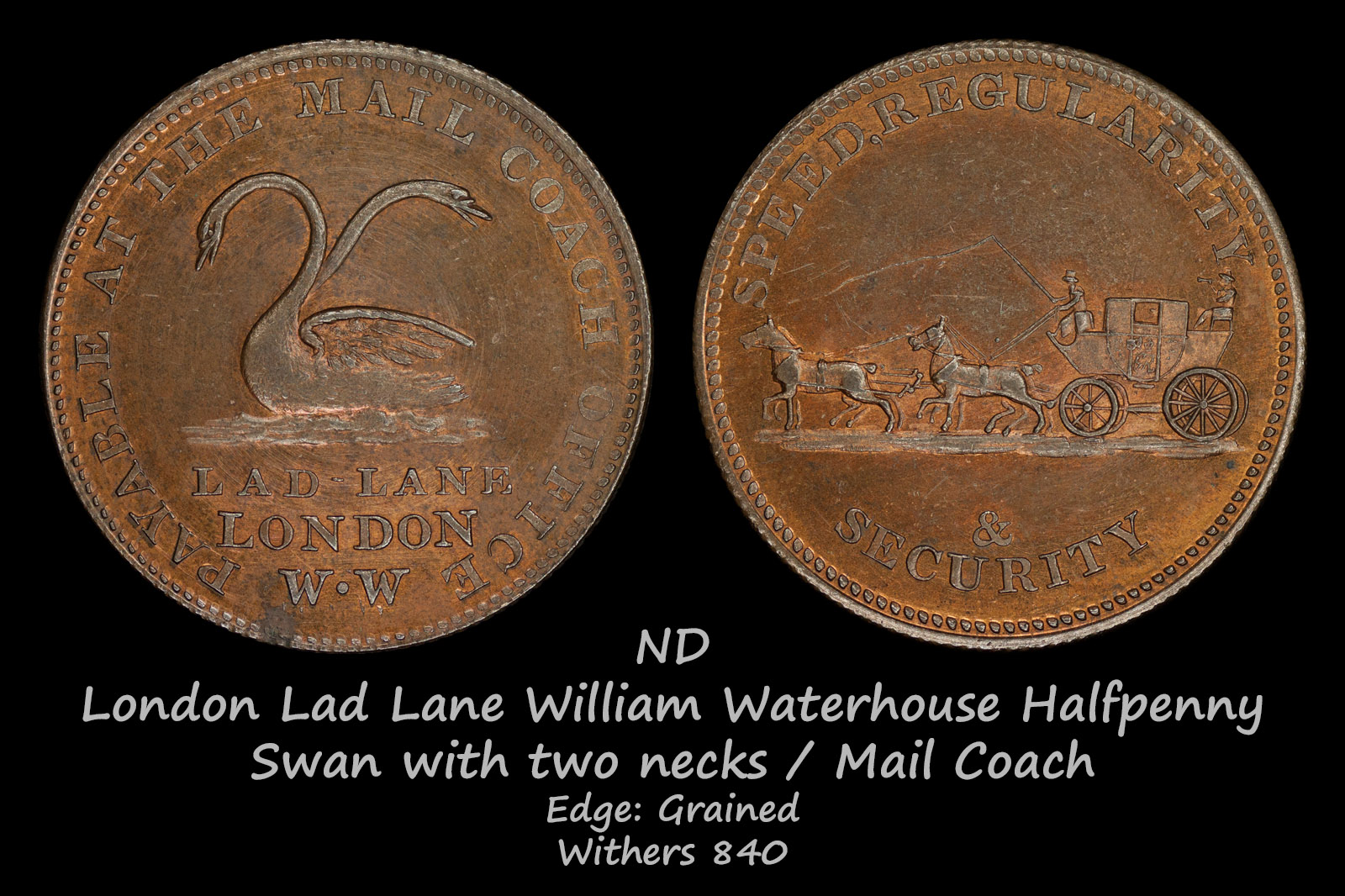
Online collections
monedastodas.com
All collections » Tokens » London Lane Halfpenny
LONDON, Lad Lane, William Waterhouse,
Halfpenny, 9.27g/12h (W 840).
Obverse: Two headed swan: “PAYABLE AT THE
MAIL COACH OFFICE LAD LANE LONDON W. W.”
Reverse: Stagecoach galloping to left:
“SPEED. REGULARITY & SECURITY.
Edge: Milled.
Provenance: FG Lawrence Collection,
Sotheby Auction, 2-4 May 1900, lot 375.
19th Century Tokens from the Collection
of the Late Francis Cocayne, DNW Auction, 2 October 2018, lot 3290.

The token was issued by order of William Waterhouse, owner of the Swan with Two Necks tavern on Lad Lane in London (originally Lady Lane, now part of Graham Street).
 The
Swan with Two Necks. Engraved by F. Rosenberg after a painting by
James Pollard. Published by J. Watson, London, 1831, The British
Museum
The
Swan with Two Necks. Engraved by F. Rosenberg after a painting by
James Pollard. Published by J. Watson, London, 1831, The British
MuseumWilliam Waterhouse was the manager of a network of mail and passenger services throughout the country. The halfpenny bears the sign of a tavern that was the final pinnacle of Palmer's historic journey (see description of the Middlesex Mail Coach Halfpenny D&H363 token ) and subsequently the hub of the UK postal network.
In 1835, the management of postal transportation passed to the Kentish coachman William Chaplin (William Chaplin 1787-?). At that time, it consisted of 68 wagons, 1800 horses and about 2000 hired workers. William Chaplin has been called the greatest stagecoach owner who ever lived. Soon, in order to invest in the development of the railway network, Chaplin sold most of the wagons and horses, and in 1867 the tavern was closed, and the buildings were subsequently rebuilt for the needs of the railway companies.
 "The
Louth-London Royal Mail Traveling by Train from Peterborough East,
Northamptonshire," by James Pollard (1845), Yale Center for British Art, oil on
canvas
"The
Louth-London Royal Mail Traveling by Train from Peterborough East,
Northamptonshire," by James Pollard (1845), Yale Center for British Art, oil on
canvasOne of the favorite subjects of the English artist James Pollard (James Pollard 1792-1867) was the image of post stagecoaches against the backdrop of English pastoral landscapes. In 1845 he painted a picture of a mail coach mounted on a train platform: "The Louth-London Royal Mail Traveling by Train from Peterborough East, Northamptonshire". It was a time of rapid development of railway networks throughout the country, which undoubtedly affected the way mail was transported.
The image of a swan with two necks can be traced back to the 1630s, when it was used as a symbol of the London tavern, which would later become the centerpiece of post stagecoaches. Traditionally, swans on the Thames were the property of the reigning monarch. However, in the 16th century, the kind Queen Bess thought it would be a good idea to let someone else have swans. She granted this right to two livery companies Dyers (Worshipful Company of Dyers) and Vintners (Worshipful Company of Vintners). In order to be able to determine who owns the swan, it was decided that the beaks of dyers' swans should be marked with one mark, and vintners with two. The sound of the word "nick" (mark) was consonant with the word "neck" (neck) and winemakers noted that a swan with two necks is a rather witty pun, therefore, on the signboards of the taverns that belonged to them, images of swans with two necks and heads began to appear. Hence the name of the London tavern "The Swan With Two Necks". Today, there are pubs with similar names in many parts of the world. Since then, marking swans has become a tradition. Every year in early July, all unmarked swans are caught on the River Thames, however, instead of marks on their beaks, ringing is now used.